The Unexpected Reason Flight Attendants Sit on Their Hands
If you’ve ever flown on a commercial airplane, you may have noticed a peculiar behavior from flight attendants during takeoff and landing – they seem to sit on their hands. While this might look like an unusual habit, it’s actually a critical safety procedure aimed at protecting both the crew and passengers in case of an emergency.
Flight attendants are not only responsible for making sure passengers are comfortable and attended to; they are highly trained professionals focused on maintaining safety during the flight. Their primary role is to manage in-flight emergencies and ensure the safety of everyone on board. One of the key safety procedures they follow is known as the “bracing position.”
A flight attendant, Henny Lim, who works for Cebu Pacific, a Philippine-based airline, went viral on TikTok after shedding light on this practice. In her video, she explains, “Ever wonder why cabin crew sits like this during takeoff and landing?” The video then cuts to a demonstration of her sitting in the “bracing position” in her jump seat.
During critical flight phases, such as takeoff and landing, the risk of an emergency or incident is statistically higher. Should something go wrong during these moments, flight attendants need to be in a position that enables them to react quickly. The bracing position is designed to achieve just that. According to Lim’s video, the bracing position involves several steps: fastening the seatbelt securely, sitting upright, and tucking the hands under the thighs with arms up and thumbs tucked in. The arms should remain relaxed, and feet should be flat on the floor. This posture helps minimize body movement during turbulence, hard landings, or unexpected impacts.
By sitting with their hands tucked and their arms in a neutral position, flight attendants reduce the risk of injury from sudden jolts or crashes. The goal is to keep the body as still as possible so that, if any impact occurs, it’s less likely to cause harm or delay their response time in an emergency. The hands and arms remain steady, preventing them from moving involuntarily, which can happen during turbulence or a hard landing. This precautionary method ensures that the crew members are ready to spring into action should they need to assist passengers in an emergency evacuation.
The video also notes that during this time, flight attendants conduct what’s called a “silent review.” This mental rehearsal helps them prepare for potential emergency scenarios, ensuring that they are focused and ready for action when needed. The silent review involves going over emergency procedures in their minds before the aircraft takes off and when preparing to land.
The video ends with Lim wishing viewers a safe flight, reinforcing that this procedure is an important part of keeping everyone safe.
While this practice may appear somewhat rigid, it is critical to flight crew safety. However, contrary to what many might assume, sitting on hands is not a strict regulation, according to veteran flight attendants. Erin Thomas, a flight attendant with over 15 years of experience, explained that the procedure of sitting on hands is more of a personal preference than an official requirement. “We need to position our hands properly as part of the brace position, and I guess you could sit on your hands if you want to,” she told Reader’s Digest. “The important thing is being in the brace position. As long as your hands aren’t holding onto the harness, that’s the most crucial part.”
Thomas shared that she prefers to keep her hands relaxed on her lap during this time. “I think it makes me look calm,” she said, noting that passengers can sense the flight attendants’ demeanor. “If we’re calm during takeoff, they will be too.” This calm presence can help reassure passengers, reducing anxiety during what can be a stressful part of the flight.
Ultimately, the key purpose of this procedure is to ensure that the crew is in the safest position possible to react quickly and help passengers in an emergency. The bracing position is about minimizing injury to flight attendants, which in turn allows them to be more effective in assisting passengers during any emergency situations.
In conclusion, the bracing position and the practice of sitting on hands during takeoff and landing may seem like a strange behavior to some passengers, but it’s part of an important safety protocol. The primary goal is to keep the crew in a steady, safe posture so they can assist passengers quickly if needed. The next time you board a flight, you’ll likely recognize this essential practice and understand why it’s so crucial for everyone’s safety during those critical moments of the flight.
